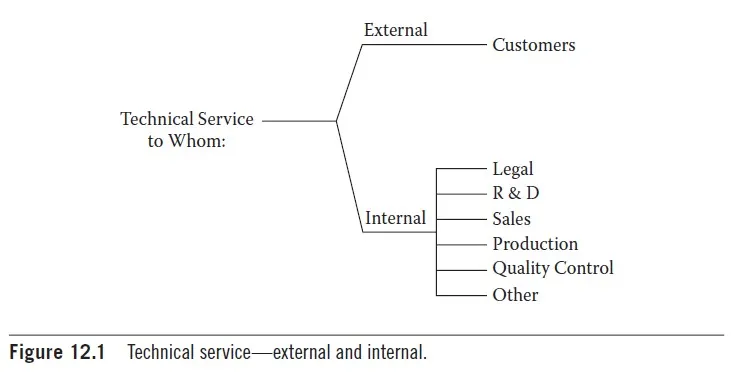The meaning of “technical service” differs among companies and industries. In essence, technical service is what an organization wants it to be; it should even function a catch-all for activities that don’t fit into other categories.
Ask yourself now:
- What is technical service in your company?
- What does one want it to be?
- what’s the difference between your customer service and your technical service?
Definition
The technical service function (person, department, division, etc.) serves others within and possibly outside the organization with regard to technical aspects of the merchandise or process by which the merchandise is made. Customer service normally handles nontechnical or minimally technical aspects of consumer products. The names clearly indicate the functions.
To whom does the technical service function respond? Figure 12.1 indicates that technical service are often external or internal. If external, it is usually founded to serve customers or potential customers. Internal technical service handles in-house issues for other areas such as research and development, legal, sales, and others.
Why is it important to define service parameters? If you are doing not clearly define the scope and responsibilities of your technical service area, everyone within the company will call technical service with questions. As a result, the department are overloaded with work, very little of which is able to make a higher product or produce more sales.
Figure 12.1 shows departments that will use technical service, but technical service may also perform preventive functions, investigate potential problems with a product or process, and proper them. In some cases, a awfully narrow line separates technical service activity from research and development.

If your technical service group will answer in-house customers (Figure 12.1), it must be able to respond rapidly. Technical problems impose urgency. A backlog of technical problems usually means a scarcity of capable people available to unravel problems fast. This lack will cost money; it’s expensive to interact qualified technical problem solvers on short notice.
Why must you define whether technical service will work to prevent problems or answer customer problems? Speed is of the essence in responding to customer problems. Preventive work usually allows more planning. This difference affects the department set-up and work schedules (see Figure 12.2).
Think also about contacts with external and internal (Figure 12.1) customers. Can a technical service representative speak and correspond with someone outside the firm without having a salesman present? Policies and practices vary among companies and products.
Many salespeople want to be involved in any discussions with their customers. Will a technical serviceperson travel with a salesman to the facility of a customer to spot a problem? Some policy should be established to hide the interactions of sales and technical people with customers and potential customers. the simplest answer would seem to have a salesman and technical person function as a team. That way, the salesperson won’t err on technical matters and therefore the technical person will not cross the road into sales.

To whom should the pinnacle of technical service report? Should he or she report back to the vp of operations or the vp of technology? Before you’ll be able to answer that you simply must consider an equipment issue. If your technical maintenance staff requires expensive equipment like mass spectrometers, you need to determine whether your research and development area has such equipment, and judge whether technical service will use it. If the research and development department in the technology area purchased the equipment and therefore the technical service group within the operations area uses it, the vice chairman of technology may not want R & D equipment utilized by operations people.
If both groups use the identical equipment, you want to determine whether it’s reasonable to shop for a second set or have the 2 areas share it. Before you buy equipment, determine who will use it, who will pay for it, and what varieties of work it’ll handle. another is for technical service to rent expensive equipment from R & D via an accounting transfer of budget funds. After these issues are resolved, you can conceive to whom the technical service group will report.
In most cases a technical service representative (tech rep) can solve problems nose to nose or by phone. Many companies outsource this function to 3rd parties, either domestically or foreign. Outsourcing is discussed in additional detail in Chapter 17. The term “offshore” is employed instead of “foreign.” Maybe they think it sounds less distant. In these cases the representatives are taught rather good English by the third party contractor. they typically answer the phone promptly and solve the problem during the conversation.
Summary
This chapter cannot determine a perfect solution for your company. You must determine the simplest set-up for technical service supported your product and your customers. However, it’s informed consider certain questions:
- What is the character of the product?
- what’s the character of problems to which technical service will respond?
- Are the “customers” of technical service internal or external?
- what quantity time are going to be available to reply to internal or external customers and handle preventive functions? (Keep in mind that the department and/or employees can serve dual functions.)
- What equipment is required?
- Will technical service have its own equipment or share equipment assigned to a different department?
- To whom will the technical service department report?
Consideration of the above factors will assist you immensely in determining the size, organization, and work assignments of a technical service group which will make the service more satisfactory to your customers and to you.


1 Comment